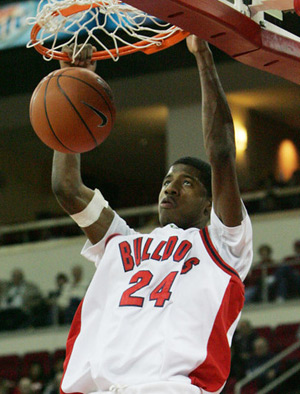RTC NBA Draft Profiles: Paul George
Posted by rtmsf on June 13th, 2010Over the course of the next month until the NBA Draft on June 24, RTC will be rolling out comprehensive profiles of the 30-35 collegians we feel have the best chance to hear their names called by David Stern in the first round that night. There won’t be any particular order to the list, but you can scroll back through all the finished profiles by clicking here.
Player Name: Paul George
School: Fresno State
Height/Weight: 6’9, 215
NBA Position: Small Forward
Projected Draft Range: Late lottery
Overview: To the casual fan, Paul George may be the least recognizable potential lottery pick, having spent his two collegiate seasons in relative obscurity on bad teams at Fresno State. National television appearances were few and far between, but when George’s Bulldogs found their way onto ESPN, he made the best of it. Last season George did a little bit of everything for the Bulldogs, averaging 16.8 PPG, 7.2 RPG, 3.0 APG and 2.2 SPG while hitting 91% of this free throws in 33 minutes per game. Still, he rarely faced elite defenders in the WAC so there is some lingering concern over the quality of competition he was doing it against, but the general feeling is that his athletic gifts and skill set are such that he will learn to excel against any defense. The key question that draftniks have about George is whether his potential and upside are worth the risk of taking him with a lottery pick, and it appears as we get closer to draft day that several teams are more than willing to give him a shot.
Will Translate to the NBA: George’s ridiculous athleticism, nearly seven-foot wingspan and astonishing leaping ability are attributes that will serve him very well at the small forward position in the NBA. He can get to the rim and finish over and through defenders when necessary. He also has exceptional range on his jumper — well beyond the college three-point line — although he can sometimes rely too much on this shot given his athleticism (43% of his field goal attempts were from distance in his two-year career). There are quite a few swing players vying for a minutes at the next level who can run and jump like George, but not many can also shoot the ball with consistency. He has had a tendency to take poor shots on occasion, but George will likely cut down on his chucker mentality when he realizes that he will not need to be the primary scoring threat in the NBA.
Needs Work: The areas of George’s game that need the most work are his sometimes sloppy handling of the ball (nearly three turnovers per game) and a lack of defensive intensity (especially considering his physical tools). These are manageable problems that can be improved upon with repetition and improved focus during game action, but they’re also the type of mistakes that will get him pulled from the game quickly at the next level. We imagine that some of this derives from being the star offensive player on a bad team and is correctable through management of his minutes and improved basketball IQ. In other words, coaching.
Comparison Players: Reliable small forwards who can shoot from distance like Trevor Ariza, Danny Granger and Rudy Gay are several of the more popular comparisons we’re hearing. George is probably a bit more athletic than those players so if he can shore up his handle and improve his shot selection, these are reasonable target players for him. Should he not improve on his deficiencies, though, then Dorell Wright may be a more apt comparison over the long run.
Best Case Scenario: The best case scenario for George is that the sky is the limit for the physically gifted wing player. He has the athleticism of a young Tracy McGrady and the jumper to ensure that defenders cannot leave him open on the perimeter. He resolves the nagging issues relating to intensity, shot selection and focus and becomes a reliable starter in short order, followed by several seasons of borderline All-Star play. We’re not sure we ever see him breaking into the rarefied air of an all-NBA selection, but he’s one of the few in this year’s draft class whose untapped potential leaves you wondering.
2013 Projection: In three years, we expect to see George starting for the team that selected him, acting as a key contributor (12/6) on the wing in the Ariza mold. He has the athletic potential to become a lockdown NBA defender, and we expect that he will take on that challenge and live up to that possibility. In fact, the defensive end more so than the offensive may be where George earns his keep in this league. We also expect that the high-flying forward will have competed in a couple NBA Slam Dunk contests by this time. Simply put, we expect that George will be a solid NBA player in three years — not a superstar, but a reliable wing for a borderline playoff team with his best years ahead of him.
Best NBA Fit: The ideal NBA fit for George coming out of the draft is a team that has consistent point guard play who will look to push the ball allowing George to terrorize transition defenders filling the lanes. It will also allow George to get comfortable finding spot-up situations for his three-point game without having to worry about doing a lot of ball-handling in the initial stages of his career. New Orleans and Chris Paul at the #11 slot would be a good situation for George, as would Memphis and Mike Conley at the #13 position.












































